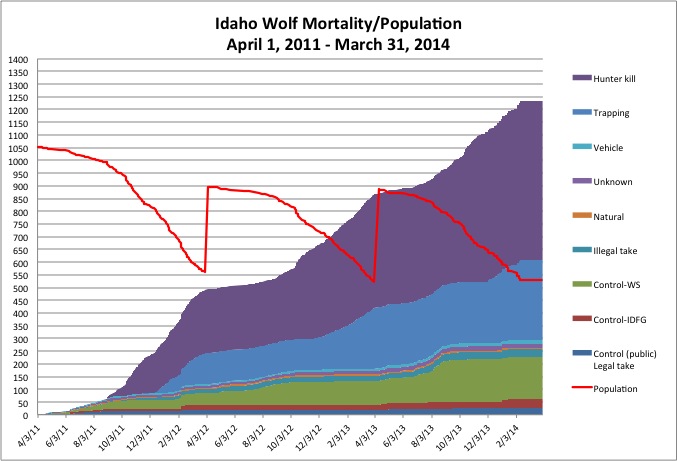by KEN COLE
The proponents’ expressed intent is for the Wolf Control Board to reduce the Idaho wolf population to 150 wolves.
A public hearing is scheduled for Monday at the Idaho State Capitol in Boise on Governor Otter’s “Wolf Control Board” bill HB470 which establishes a board which would composed solely of people appointed by the Governor.
The membership of the board shall consist at all times of members representing the following executive agencies and interests:
(a) The director of the department of agriculture
(a) The director of the department of agriculture;
(b) The director of the department of fish and game;
(c) A member representative of sportsmen’s interests;
(d) A member representative of the livestock industry; and
(e) A member of the public at large, not to exclude any person who may have sportsmen or livestock interests.
The Committee will be taking public testimony on the bill and people who plan to attend should arrive early to be sure that their testimony will be heard. Those who cannot attend can listen to audio from the House Resources and Conservation Committee.
| What: | Resource and Conservation Committee Public Hearing for HB 470 |
| When: | Monday February 17th at 1:30pm |
| Where: | Idaho State Capitol Room EW40 700 W Jefferson Boise, ID 83720 |
As one of only three major issues Governor Otter proposed in his State of the State Address, the “Wolf Control Board” is clearly one of his highest priorities.
One form of growth we don’t want to encourage is in the wolf population that was imposed on us almost twenty years ago. With your unflinching support we were able to fight through the opposition of those who would make Idaho a restricted use wildlife refuge and take back control of these predators from our federal landlords. Now we’re managing them now, and they’re a trophy hunting species (sic), and the population is still growing, and our resources remain at risk. So I’m calling for the establishment of a wolf control fund and a state board to direct and manage it. My budget recommendation that calls for a one-time allocation of two-million dollars to get the fund started. That base could be… would be augmented with continuing annual contributions of at least a hundred-and-ten-thousand dollars from the livestock industry and a matching amount from the Idaho sportsmen. This three-pronged approach will provide the revenues needed to effectively control Idaho’s burgeoning wolf population and ease the impact on our livestock and our wildlife. – Governor Clement Leroy “Butch” Otter at his January 6, 2014 State of the State Address
However, the Governor’s assertion that the wolf population is increasing is contradicted by monitoring conducted by the Idaho Department of Fish and Game which shows that the population has declined by 30% since Idaho took over management of the species in 2009. Mortality records obtained through public records requests and published on the Idaho Department of Fish and Game website indicate that the population is likely to fall to around 460 animals by the end of March 2014 just before female wolves begin denning activities. Presently the population, based on the preliminary estimate of “less than 600″ wolves at the end of December given to the legislature by Idaho Department of Fish and Game biologist Jeff Gould, is around 530 since about 70 wolves have been killed since then.
During the period from April 1, 2011 to the present 1,232 wolf mortalities have been documented by the Idaho Department of Fish and Game. 98.1% (n=1,209) of those mortalities were human caused, 1.4%, (n=17) were unknown, and 0.5% (n=6) were natural.
The board would be started with $2 million from the General Fund and in subsequent years would be funded with $110,000 from the livestock industry and $110,000 from Idaho Department of Fish and Game license funds.

